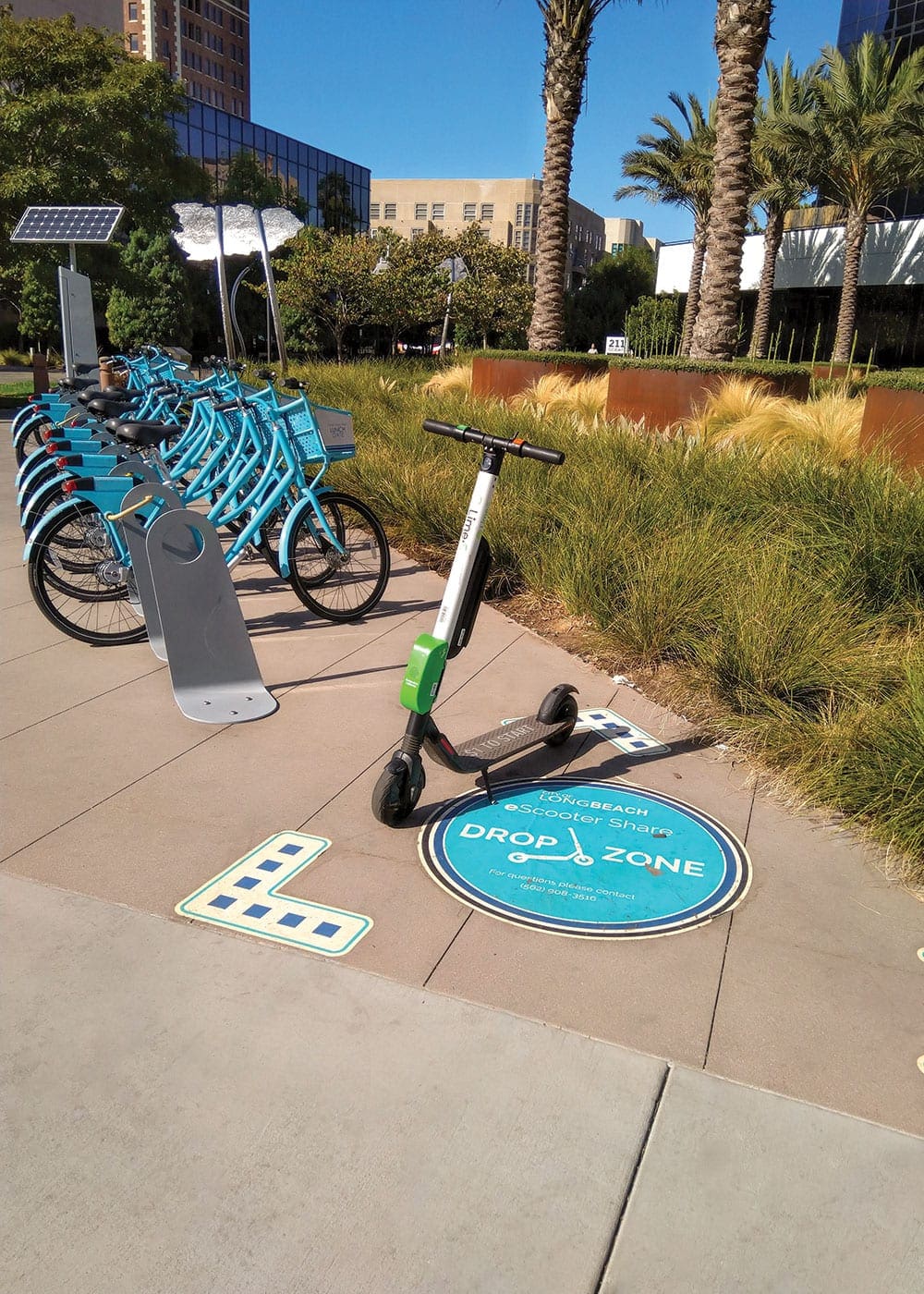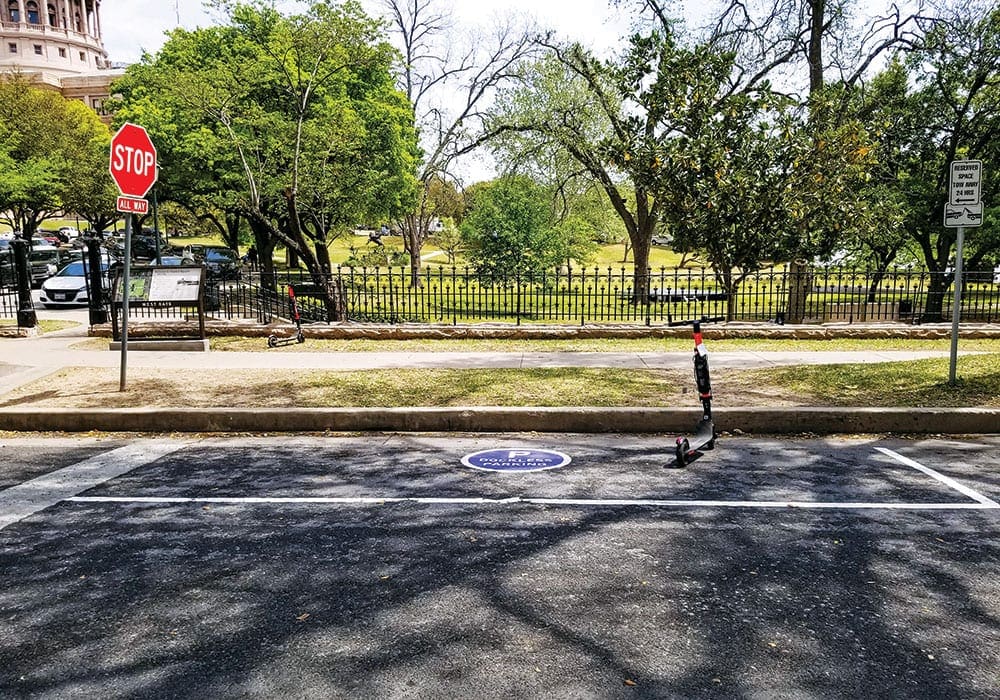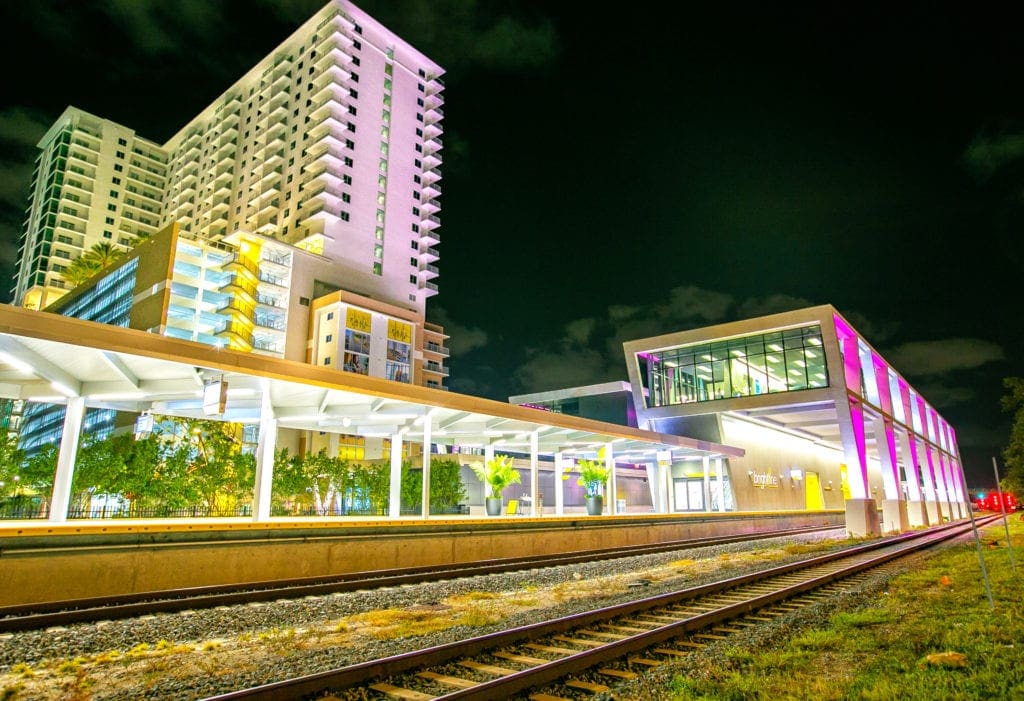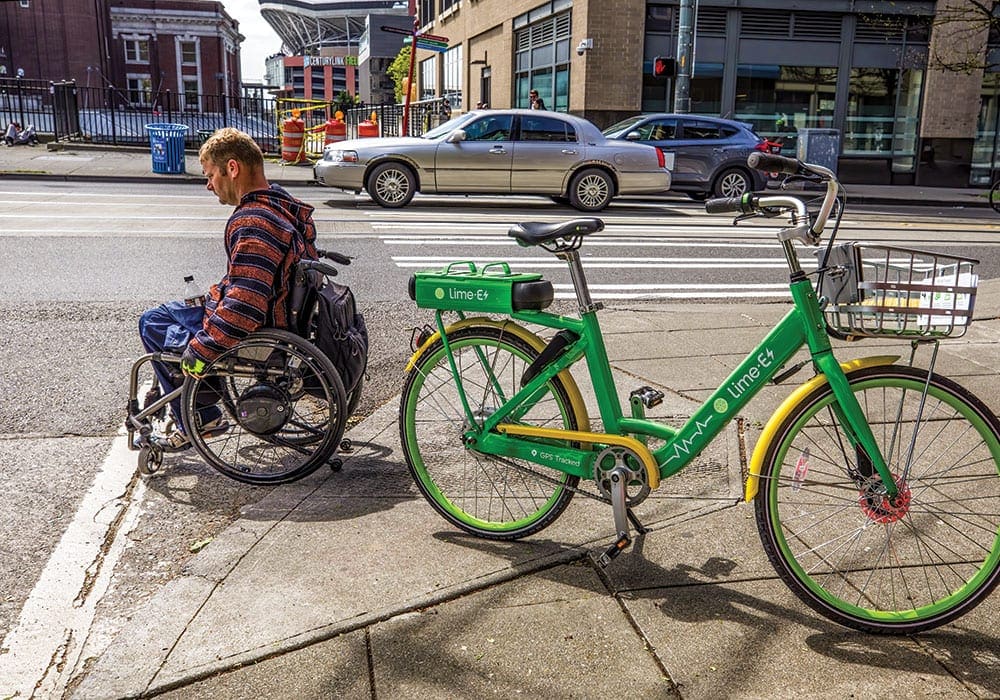By Steve Wright – Full Article
Micromobility promises an environmentally friendly way of solving first/last mile needs while getting more people out of their cars and onto transit. Provided by for-profit companies with billions in investment capital, these light, low-speed vehicles — like electric scooters and shared bicycles — create a new mobility mode, seemingly without a direct hit to stressed city budgets.
Sounds like a dream solution from urban planning heaven, and in many cases, it is. But for people with disabilities, especially those who use assistive mobility devices like wheelchairs, uncontrolled dockless micromobility represents a giant, painful setback in essential urban mobility.
Scooters and bikes provide options for those who are young, healthy, and physically able. They are out of reach for the nearly three million people who use wheelchairs for mobility in the U.S. (67 million worldwide) and a significant percentage of the 40.7 million Americans who report that some kind of disability impacts their daily lives.
Dockless bikes and scooters also pose literal barriers when they block sidewalks and passageways, denying basic civil rights under the Americans with Disabilities Act.
“Municipalities cannot just look at bikes and scooters as ‘free’ first/last mile solutions and not plan for the consequences,” says Mark Ezzell, director of the North Carolina Governor’s Highway Safety Program, who uses a wheelchair for mobility. “If you don’t create regulations, then you create a Wild West situation where micromobility devices are blocking curb ramps, crosswalks, bus stops … and that is not just a problem for wheelchair users — it is an access issue for families pushing strollers, blind people, really every pedestrian who cannot maneuver because of the clutter.”
According to Jana Lynott, AICP, senior strategic policy advisor at AARP’s Public Policy Institute, micromobility offers a lot of positives, including increasing transportation options, encouraging higher transit use and lower private vehicle use, and reducing greenhouse gas emissions. “But by and large I am concerned that those advocating for greater use of dockless scooters and bikes are not taking safety and accessibility concerns seriously enough,” Lynott says, adding that these goals should not be achieved on “the backs of those individuals in our community who have historically, and who continue to be, the least well served by our current transportation system.”
Bike share and dockless scooters are not going away any time soon, so Ezzell says it’s up to cities to ensure micromobility options don’t leave anyone behind. Local governments should take a proactive approach to crafting policies and regulations for micromobility services that work for all people.
Inclusive micromobility
Micromobility can be inclusive if planners “ground ourselves in the principles of good urban design and right-of-way management that we already know,” says Jean Crowther, AICP, the New Mobility Group Leader at Alta Planning + Design. “It’s just a matter of recognizing how new modes, new devices, new services fit within existing goals and policies.”
“Getting ahead of accessibility issues and wrapping that into how shared mobility services are permitted and managed is critical,” Crowther says. “This can come in the form of incentives or penalties related to parking behavior and establishing clear processes for tracking impacts to accessibility.” She points to Oakland, California, which requires scooter providers to offer a more accessible option with a seat and a wider wheelbase.
But the first step to ensuring micromobility options are as inclusive as possible for people with disabilities is engagement. “The planning process, before the bikes or scooters come into the city, must have the disability community involved. And planners must realize every kind of disability is impacted by new mobility, so get lots of different people to the table — folks with mobility, vision, hearing, and cognitive disabilities,” says Ezzell.
This type of engagement has been a major priority for Chicago, which has taken its micromobility regulatory process slower than many cities. It launched a four-month scooter pilot program last summer, allowing 10 companies to deploy 2,500 scooters on the city’s West Side. The program ended in October, but prior to launch, it received strong input from the Mayor’s Office for People with Disabilities (MOPD).
Karen Tamley, former commissioner of MOPD, was tasked by Mayor Lori Lightfoot with helping to make Chicago fully accessible. She says the city reached out to individual wheelchair users and people with visual impairments and solicited input from organizations that advocate for people with disabilities in order to anticipate conflicts, problems, and safety issues well before the pilot rolled out.
“The best engagement practice that planners can use is being proactive in inviting people with a wide range of disabilities to be at the table throughout a process. Don’t wait [until] after the complaints come in,” says Tamley, who uses a wheelchair for mobility. And, she adds, planners and others need to get in front of new mobility options before they get too entrenched to enforce proper controls on them.
Tamley says the stakeholder feedback propelled two of the scooter pilot’s rules: One, all scooters had to be taken off the streets between 10 p.m. and 5 a.m. by the firms deploying them, and two, scooters could only be ridden in the street, not on sidewalks. “We [also] put in a lot of rules about where [the scooters] could be dropped off,” says Tamley.
Whether cities are planning for dockless scooters, overhauling transit stations to increase access, or ensuring equity and access in the app-based mobility age, Tamley says, “It’s critical that we have these conversations with input from and strong consideration for the disability community. If we do not, things will happen without the disability lens.”
Accessibility action plan
Lisa Nisenson, vice president of New Mobility and Connected Communities at WGI, a professional services firm providing planning and engineering — and a member of the American Planning Association’s Smart City Task Force — wrote some of the first regulatory language for micromobility. She says successful micromobility programs often provide corrals for dockless bikes and scooters, and they have an enforcement component.
“Smart regulations first give a reward for companies that remove discarded bikes [and] scooters that block mobility. The next step is a penalty phase to fine them for bad behavior,” she says.
Portland, Oregon; Seattle; and Austin, Texas, are among the cities getting it right. Seattle reached out to sidewalk and mobility stakeholders, including merchants, bicycle groups, and disability rights advocates, to shape a scooter pilot scheduled to launch this spring. The results of outreach will inform the pilot program and the city’s broader policies on parking and roadway and trail use, as well as a monitoring system to correct, or even prevent, problems associated with dockless mobility systems.
Portland uses incentives that allow permitted micromobility companies to increase scooter fleet size once they meet performance targets. For example, Spin was allowed to add nearly 200 scooters after developing a program to deter riders from illegally using them on sidewalks and encouraging riding safety, Nisenson says.
In Austin, Jacob Culberson, the city’s manager of mobility services, says equitable access for all people to all places is the goal. “We’d love to see an accessibility-focused micromobility device enter the market. Until that happens, though, we’ve worked with the Austin City Council to update rules and regulations regarding the parking of micro-mobility devices, prohibiting them from impeding curb ramps and bus stops and generally providing more clarity to users and enforcement to ensure accessibility for all,” Culberson says.
Austin’s rules specify that micromobility units cannot be parked within or immediately adjacent to ADA accommodations — including curb ramps, braille signs, railings, and signal push buttons — or in bus stops, shelters, passenger waiting areas, and bus layover and staging zones. Disabled parking zones also are off-limits for scooter and bike parking.
The city has designated “No Deploy Zones,” areas where micromobility companies are prohibited from placing their devices, such as surrounding the Texas School for the Blind, Austin Medical Plaza, and other select locations.
Austin also requires micromobility firms to have customer service phone lines or apps and websites that are responsive 24/7. They must also have visible language that notifies device users of the city’s “Dockless Mobility Code of Ethics.”
Culberson’s tips to other cities who want to ensure that micromobility is an asset to accessibility, not a detriment, include working closely with micromobility companies to ensure they are:
Continually policing their own devices
Remaining highly responsive to service requests
Never releasing more devices than their field teams can handle
For AARP’s Lynott, an expert in livable communities, the absolute best practice would be requiring all scooters and bikes be docked. Otherwise, she says, “We are absolutely going backward in our commitment to the Americans With Disabilities Act.”
Lynott also suggests cities adopt Mobility Data Specification (MDS) protocols for data sharing that help local governments standardize and manage their dockless micromobility programs.
In 2018, the Los Angeles Department of Transportation created an MDS system that requires permitted shared-use mobility companies to provide real-time information about how many of their vehicles are in use at any given time, where vehicles are at all times, and the physical condition of vehicles.
The city can use data to inform policy decisions and even actively communicate with companies and their customers in real time if a vehicle is parked illegally in the public right-of-way, though the system has proven controversial among mobility companies and privacy advocates.
LA has since open-sourced the software that makes the MDS run, and today more than a dozen cities around the U.S. are using MDS to collect data to manage dockless vehicles, including Austin, San Jose, California; Providence, Rhode Island; and Louisville, Kentucky.

Path to universal mobility
While some see micromobility options like scooters as a menace, “they are forcing conversations about how we accommodate slow mobility and infrastructure for all forms [of transportation],” Nisenson says.
Experts like Judy Shanley, codirector of the National Center for Mobility Management and assistant vice president at Easterseals, say those conversations are critical for communities.
Mobility equity isn’t just a matter of doing the right thing, it’s a best practice that greatly strengthens local economy and culture, she says.
“People with disabilities contribute to the tax base, culture, and vibrancy of the community,” notes Shanley, and cities should be planned with their needs and input in mind. “If they are being excluded, it creates very negative consequences to the entire community — not just for people with disabilities.”
One area is the economy. People with disabilities have the highest rate of unemployment and underemployment of any minority group in the U.S., according to Bureau of Labor Statistics data. This is largely attributed to lack of mobility, not the core condition causing the disability.
A lack of access to health care likewise has impacts, affecting not just individuals with disabilities but the entire economic sector.
“Equity also involves town planning that locates libraries, farmers markets, social services, health care and jobs at transit stops,” Shanley adds. “With the explosion of new mobility options, managing transit in collaborative ways that coordinate various modes of travel is going to be crucial for cities that want to grow and sustain strong economies.”
Steve Wright (Twitter: @stevewright64) is a journalist and marketing communications consultant in Miami, where he lives with his wife Heidi Johnson-Wright, an ADA expert. Wright blogs about urban design and accessibility.





















